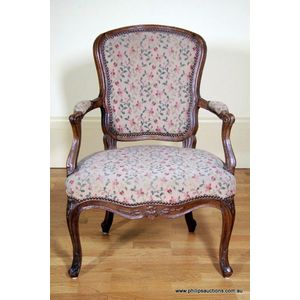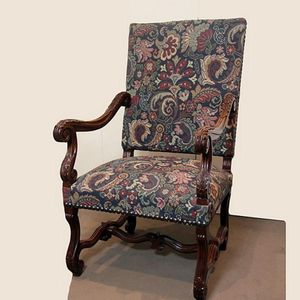Queen Anne Walnut Wing Armchair with Fine Tapestry Upholstery
You must be a subscriber, and be logged in to view price and dealer details.
Subscribe Now to view actual auction price for this item
When you subscribe, you have the option of setting the currency in which to display prices to $Au, $US, $NZ or Stg.
- Circa - A Latin term meaning 'about', often used in the antique trade to give an approximate date for the piece, usually considered to be five years on either side of the circa year. Thus, circa 1900 means the piece was made about 1900, probably between 1895 and 1905. The expression is sometimes abbreviated to c.1900.
- Provenance - A term used to describe the provable history of an antique or work of art, and thus an additional aid to verifying its authenticity. Provenance can have an inflating effect on the price of an item, particularly if the provenance relates to the early settlement of Australia, a famous person, or royalty. Less significant are previous sales of the item through an auction house or dealer.
- Cabriole Leg - The cabriole leg evolved from an elongated scroll, curving out at the knee which may or may not be carved, and forming a serpentine shape as it descends to the foot.
First introduced into English furniture in the late 17th century, cabriole legs were widely used during the Queen Anne and early Georgian periods, where they frequently terminated in a pad foot or ball and claw foot. The style has had many imitators since then. The cabriole leg was re-introduced in the mid-19th century, and is commonly associated with the balloon-back dining or drawing-room chairs made in walnut, mahogany or, in Australia, cedar. The Victorian cabriole leg, on the whole, was rather more slender than the earlier form, following the French style, which emphasized the delicacy and daintiness of the chairs they were designed to support. Cabriole legs are sometimes found on windsor chairs, especially those made during the 18th century. - Cartouche - An ornamental panel in the form of of a shield, oval or rectangular scroll with curling edges. It may be carved into the back of a chair or the top of a sideboard, or present on a piece of silver or jewellery, and contain the initials of the original owner, heraldic symbols, or some other inscription, such as the details of a presentation.
In ceramics the term defines the central area of a vase or similar with a decorative border in one of the shapes above, into which a decorative scene or figures have been painted.
This item has been included into following indexes:
-
chairs, singles / pairs / threes, style or period
- armchairs 1,732
- Queen Anne style 20
- wing back 105
- chairs, singles / pairs / threes, timber - walnut 693
Visually similar items

A Louis XV-style walnut fauteuil, 19th century, possibly earlier, the moulded frame decorated with carved decorative details, upholstered in close-nailed floral fabric. Height 88 cm. Width 61 cm. Depth 64 cm.

French Louis XIV style oak fauteuil, with a padded back and armrests on scroll supports, with a padded seat on short turned carved legs, with carved stretcher

A set of six upholstered Louis XV style dining chairs, early 20th century, the high back padded and arched cherry wood chairs with a light metallic painted finish, with curvaceous arms and supports to stuffover seats and raised on cabriole legs with whorl

A Louis XV giltwood Begere c1880
